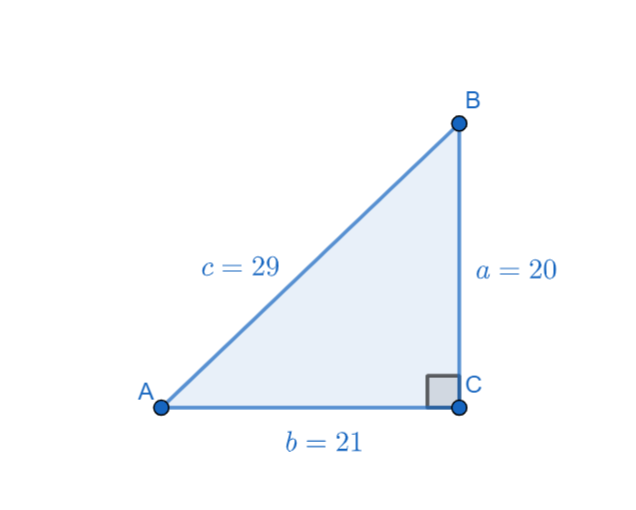Answer
385.5k+ views
Hint: In this problem we have to calculate the values of six trigonometric ratios for a given right angled triangle. First, we will draw a diagram of the given right angled triangle with all the data we have. We need to represent all the data like side lengths, angels we have in the given problem. Now we will consider the two vertices other than the right angled vertex and we will write the adjacent, opposite ide to the respective vertex. Now we will use the basic definitions of the trigonometric ratios and calculate the values of the trigonometric ratios for both the vertices in the triangle.
Complete step-by-step solution:
Given that, $ABC$ is a right-angle triangle with right angle at $C$. Hence the triangle $ABC$ is represented as

Now we have the values of side lengths of the above triangle as $a=20$, $b=21$, $c=29$. Now the above triangle is represented as

In the above triangle the hypotenuse is $AB=c=29$
Now considering the angle $\angle BAC$ in the above triangle. Adjacent side to the angle $\angle BAC$ is $AC=b=21$, Opposite side to the angle $\angle BAC$ is $BC=a=20$.
From the basic definitions of the trigonometric ratios, we have the values of all trigonometric ratios as
$\sin A=\dfrac{\text{Opposite side}\left( a \right)}{\text{Hypotenuse}\left( c \right)}=\dfrac{20}{29}$,
$\cos A=\dfrac{\text{Adjacent side}\left( b \right)}{\text{Hypotenuse}\left( c \right)}=\dfrac{21}{29}$,
$\tan A=\dfrac{\text{Opposite side}\left( a \right)}{\text{Adjacent side}\left( b \right)}=\dfrac{20}{21}$,
$\cot A=\dfrac{\text{Adjacent side}\left( b \right)}{\text{Opposite side}\left( a \right)}=\dfrac{21}{20}$,
$\sec A=\dfrac{\text{Hypotenuse}\left( c \right)}{\text{Adjacent side}\left( b \right)}=\dfrac{29}{21}$,
$\csc A=\dfrac{\text{Hypotenuse}\left( c \right)}{\text{Opposite side}\left( a \right)}=\dfrac{29}{20}$.
Now considering the angle $\angle ABC$ in the above triangle. Adjacent side to the angle $\angle ABC$ is $BC=a=20$, Opposite side to the angle $\angle ABC$ is $AC=b=21$.
From the basic definitions of the trigonometric ratios, we have the values of all trigonometric ratios as
$\sin B=\dfrac{\text{Opposite side}\left( b \right)}{\text{Hypotenuse}\left( c \right)}=\dfrac{21}{29}$,
$\cos B=\dfrac{\text{Adjacent side}\left( a \right)}{\text{Hypotenuse}\left( c \right)}=\dfrac{20}{29}$,
$\tan B=\dfrac{\text{Opposite side}\left( b \right)}{\text{Adjacent side}\left( a \right)}=\dfrac{21}{20}$,
$\cot B=\dfrac{\text{Adjacent side}\left( a \right)}{\text{Opposite side}\left( b \right)}=\dfrac{20}{21}$,
$\sec B=\dfrac{\text{Hypotenuse}\left( c \right)}{\text{Adjacent side}\left( a \right)}=\dfrac{29}{20}$,
$\csc B=\dfrac{\text{Hypotenuse}\left( c \right)}{\text{Opposite side}\left( b \right)}=\dfrac{29}{21}$.
Note: In this problem we have a lot of data related to triangles. So, it is easy to solve when we have the diagrammatic representation of the given data. Without representing the given triangle, it will be very hard to solve the problem.
Complete step-by-step solution:
Given that, $ABC$ is a right-angle triangle with right angle at $C$. Hence the triangle $ABC$ is represented as

Now we have the values of side lengths of the above triangle as $a=20$, $b=21$, $c=29$. Now the above triangle is represented as

In the above triangle the hypotenuse is $AB=c=29$
Now considering the angle $\angle BAC$ in the above triangle. Adjacent side to the angle $\angle BAC$ is $AC=b=21$, Opposite side to the angle $\angle BAC$ is $BC=a=20$.
From the basic definitions of the trigonometric ratios, we have the values of all trigonometric ratios as
$\sin A=\dfrac{\text{Opposite side}\left( a \right)}{\text{Hypotenuse}\left( c \right)}=\dfrac{20}{29}$,
$\cos A=\dfrac{\text{Adjacent side}\left( b \right)}{\text{Hypotenuse}\left( c \right)}=\dfrac{21}{29}$,
$\tan A=\dfrac{\text{Opposite side}\left( a \right)}{\text{Adjacent side}\left( b \right)}=\dfrac{20}{21}$,
$\cot A=\dfrac{\text{Adjacent side}\left( b \right)}{\text{Opposite side}\left( a \right)}=\dfrac{21}{20}$,
$\sec A=\dfrac{\text{Hypotenuse}\left( c \right)}{\text{Adjacent side}\left( b \right)}=\dfrac{29}{21}$,
$\csc A=\dfrac{\text{Hypotenuse}\left( c \right)}{\text{Opposite side}\left( a \right)}=\dfrac{29}{20}$.
Now considering the angle $\angle ABC$ in the above triangle. Adjacent side to the angle $\angle ABC$ is $BC=a=20$, Opposite side to the angle $\angle ABC$ is $AC=b=21$.
From the basic definitions of the trigonometric ratios, we have the values of all trigonometric ratios as
$\sin B=\dfrac{\text{Opposite side}\left( b \right)}{\text{Hypotenuse}\left( c \right)}=\dfrac{21}{29}$,
$\cos B=\dfrac{\text{Adjacent side}\left( a \right)}{\text{Hypotenuse}\left( c \right)}=\dfrac{20}{29}$,
$\tan B=\dfrac{\text{Opposite side}\left( b \right)}{\text{Adjacent side}\left( a \right)}=\dfrac{21}{20}$,
$\cot B=\dfrac{\text{Adjacent side}\left( a \right)}{\text{Opposite side}\left( b \right)}=\dfrac{20}{21}$,
$\sec B=\dfrac{\text{Hypotenuse}\left( c \right)}{\text{Adjacent side}\left( a \right)}=\dfrac{29}{20}$,
$\csc B=\dfrac{\text{Hypotenuse}\left( c \right)}{\text{Opposite side}\left( b \right)}=\dfrac{29}{21}$.
Note: In this problem we have a lot of data related to triangles. So, it is easy to solve when we have the diagrammatic representation of the given data. Without representing the given triangle, it will be very hard to solve the problem.
Recently Updated Pages
How many sigma and pi bonds are present in HCequiv class 11 chemistry CBSE

Why Are Noble Gases NonReactive class 11 chemistry CBSE

Let X and Y be the sets of all positive divisors of class 11 maths CBSE

Let x and y be 2 real numbers which satisfy the equations class 11 maths CBSE

Let x 4log 2sqrt 9k 1 + 7 and y dfrac132log 2sqrt5 class 11 maths CBSE

Let x22ax+b20 and x22bx+a20 be two equations Then the class 11 maths CBSE

Trending doubts
Fill the blanks with the suitable prepositions 1 The class 9 english CBSE

At which age domestication of animals started A Neolithic class 11 social science CBSE

Which are the Top 10 Largest Countries of the World?

Give 10 examples for herbs , shrubs , climbers , creepers

Difference between Prokaryotic cell and Eukaryotic class 11 biology CBSE

Difference Between Plant Cell and Animal Cell

Write a letter to the principal requesting him to grant class 10 english CBSE

Change the following sentences into negative and interrogative class 10 english CBSE

Fill in the blanks A 1 lakh ten thousand B 1 million class 9 maths CBSE



